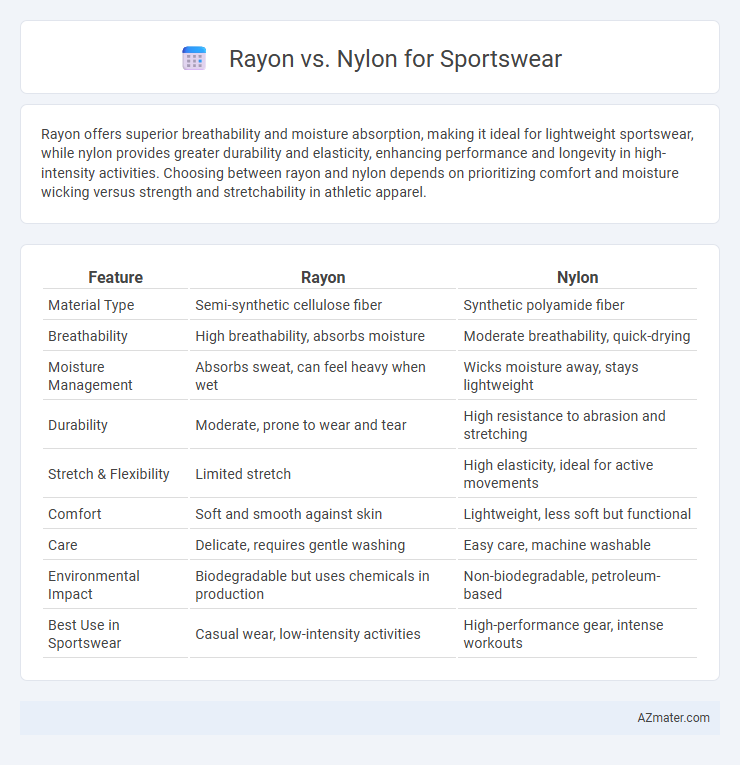Rayon offers superior breathability and moisture absorption, making it ideal for lightweight sportswear, while nylon provides greater durability and elasticity, enhancing performance and longevity in high-intensity activities. Choosing between rayon and nylon depends on prioritizing comfort and moisture wicking versus strength and stretchability in athletic apparel.
Table of Comparison
| Feature | Rayon | Nylon |
|---|---|---|
| Material Type | Semi-synthetic cellulose fiber | Synthetic polyamide fiber |
| Breathability | High breathability, absorbs moisture | Moderate breathability, quick-drying |
| Moisture Management | Absorbs sweat, can feel heavy when wet | Wicks moisture away, stays lightweight |
| Durability | Moderate, prone to wear and tear | High resistance to abrasion and stretching |
| Stretch & Flexibility | Limited stretch | High elasticity, ideal for active movements |
| Comfort | Soft and smooth against skin | Lightweight, less soft but functional |
| Care | Delicate, requires gentle washing | Easy care, machine washable |
| Environmental Impact | Biodegradable but uses chemicals in production | Non-biodegradable, petroleum-based |
| Best Use in Sportswear | Casual wear, low-intensity activities | High-performance gear, intense workouts |
Introduction to Rayon and Nylon
Rayon, a semi-synthetic fiber made from cellulose, offers exceptional breathability and moisture absorption, making it suitable for lightweight sportswear. Nylon, a fully synthetic polymer known for its high strength and elasticity, provides durability and excellent resistance to abrasion and mildew in athletic apparel. Both fibers serve distinct purposes in sportswear design, with rayon enhancing comfort and nylon improving longevity.
Key Differences Between Rayon and Nylon
Rayon is a semi-synthetic fiber known for its breathability and softness, making it ideal for moisture absorption in sportswear, while nylon is a fully synthetic fiber prized for its durability, elasticity, and resistance to abrasion and mildew. Nylon sportswear provides superior stretch and quick-drying properties, enhancing performance in high-intensity activities, whereas rayon tends to offer a more comfortable, natural feel but dries slower and is less resilient. The key differences lie in rayon's natural-like texture and moisture-wicking ability versus nylon's strength, elasticity, and fast-drying capabilities essential for rigorous sportswear use.
Moisture-Wicking Abilities
Nylon excels in moisture-wicking due to its hydrophobic fibers that quickly draw sweat away from the skin, keeping athletes dry during intense workouts. Rayon, although breathable and lightweight, tends to absorb moisture rather than wick it, leading to longer drying times and potential discomfort. For sportswear focused on high-performance moisture management, nylon remains the preferred fabric for superior sweat evaporation and sustained comfort.
Breathability and Comfort Levels
Rayon fabric offers superior breathability as it is made from natural cellulose fibers, allowing moisture to evaporate quickly and keep the skin cool during intense physical activities. Nylon, while highly durable and moisture-wicking, tends to trap heat and can cause discomfort due to lower air permeability compared to rayon. Athletes seeking maximum comfort and ventilation often prefer rayon-based sportswear for enhanced airflow and softness against the skin.
Stretch and Flexibility Comparison
Rayon offers moderate stretch and flexibility but lacks the elasticity found in nylon, making it less ideal for high-movement sportswear. Nylon excels in stretch and recovery due to its inherent elasticity, providing superior flexibility and durability in athletic wear. Sportswear composed primarily of nylon supports dynamic motion and maintains shape better under stress compared to rayon fabrics.
Durability and Longevity
Nylon offers superior durability and resistance to abrasion compared to rayon, making it ideal for high-performance sportswear subjected to intense physical activity. Rayon, while breathable and comfortable, tends to degrade faster when exposed to moisture and repeated washing, reducing its longevity. Sportswear designed for long-term use benefits from nylon's strength and resilience, ensuring extended wear without significant damage.
Care and Maintenance Requirements
Rayon sportswear demands delicate handling with cold water washes and air drying to prevent shrinkage and fabric weakening, while nylon requires less maintenance, tolerating machine washes and quick drying due to its synthetic durability. Both fabrics benefit from avoiding high heat and harsh detergents to maintain elasticity and color vibrancy. Proper care extends the lifespan and performance of rayon and nylon garments during rigorous sports activities.
Environmental Impact and Sustainability
Rayon, derived from natural cellulose, offers biodegradability but involves chemically intensive production processes that can harm ecosystems if unmanaged, while nylon, a synthetic polymer, relies heavily on non-renewable petroleum resources and contributes to microplastic pollution during washing. Sustainable innovations in both fibers include the development of recycled nylon and closed-loop rayon manufacturing, reducing environmental footprints associated with raw material extraction and waste generation. Choosing sportswear made from responsibly sourced and certified fabrics supports lower carbon emissions and promotes circular economy practices in the textile industry.
Cost Analysis: Rayon vs Nylon Sportswear
Rayon sportswear typically costs less than nylon, making it a budget-friendly option for consumers seeking breathable and moisture-absorbent fabrics. Nylon's higher price reflects its superior durability, elasticity, and resistance to abrasion, which are essential for intense physical activities and long-term use. Choosing between rayon and nylon depends on balancing upfront costs with the longevity and performance requirements of the sportswear.
Which is Better for Sportswear: Rayon or Nylon?
Nylon outperforms rayon for sportswear due to its superior durability, moisture-wicking properties, and resistance to abrasion, making it ideal for high-intensity activities. Rayon, while soft and breathable, lacks the quick-drying and stretch capabilities essential for optimal athletic performance. Choosing nylon ensures enhanced comfort, flexibility, and longevity in sports apparel.

Infographic: Rayon vs Nylon for Sportswear
 azmater.com
azmater.com